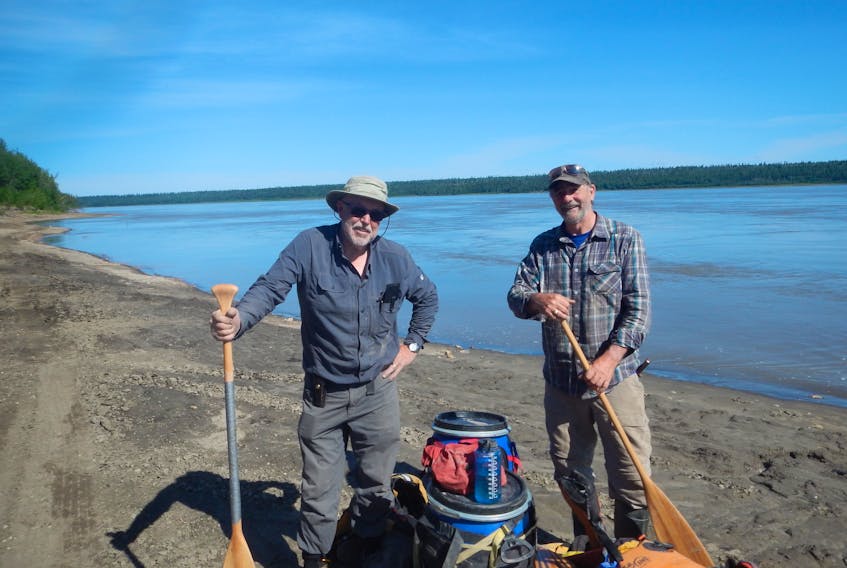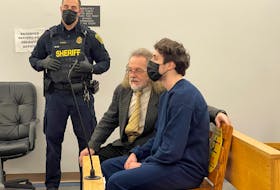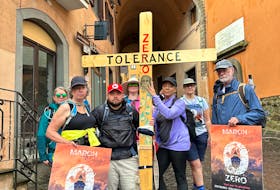ST. JOHN'S, N.L. — It took three days longer than he projected, but a St. John’s man was able to navigate the fur trading routes of days gone by.
Herman Perry, a retired outdoor enthusiast, and his brother-in-law, Paul Snow, departed La Loche, Sask., on June 16, and 53 days later — on Aug. 7, made it to Arctic Red River/Tsiigecheck, N.W.T.

“Along the way we chatted with moose hunters, duck hunters and fishermen who were living off the land and enjoying their subsistence-type lifestyle,’’ Perry said.
“In addition, we kept in contact with my brother, Larry, who was driving up to Arctic Red River to pick us up and kept abreast of progress in spite of weather delays and recent cold wind and rain that had lasted for several days,’’ he added.
They had been dropped off at La Loche by Larry, who lives in Saskatoon.
They paddled across Lake La Loche, up the La Loche Creek for a kilometre from Wallis Bay and then carried their food, gear and canoe across the legendary Methy Portage to the Clearwater River.
“We brought along a two-wheeled cart for moving the canoe across the 20-kilometre Methy portage, but unfortunately the axle broke shortly after we started and this canoe portage became a slugfest,’’ Perry said.
“The temperature was around 30 C and we blistered our feet badly while walking back and forth with our backpack loads.’’
They paddled the Clearwater, Athabasca, Slave and Mackenzie rivers, and Great Slave Lake, as they followed the historic Old Voyagers Fur Trade Route for 2,752 kilometres to the northwest.

They had estimated 50 days for the trip, but with portaging delays and weather delays it took them 53 days.
Fur trade history
The fur trade is part of Canada’s resource-based economy and one of Canada’s oldest and most historically significant industries.
The commercial fur trade continues — 400 years after it started — and is an important contributor to the Canadian economy and ecology, Perry said.
This 2019 trip from La Loche to Arctic Red River was a continuation of the 2018 canoe trip along the Old Voyager Fur Trade Route between La Loche, Sask. and York Factory on Hudson Bay.
Another trip is planned. The 2020 canoe trip will be a 2,500-kilometre paddle. It will likewise last about 50 days and be a continuation of this year’s canoe trip.
It will start in Arctic Red River, and proceed down the Mackenzie and Peel rivers to the confluence with the Rat River. From the Rat River it will be nine days of tracking and portaging up and over the Rockies to Summit Lake, then from Summit Lake they will paddle due west on the Bell, Porcupine and Yukon rivers across Alaska to Emmonak on the Bering Sea.

“On hot days we relished wading and swimming in the rivers and lakes, but we also looked forward to the hotel showers, clothes washing and restaurant meals during rest days,’’ Snow said.
“At the villages we came across, we located and took photos of some of the old Hudson Bay Co. trading post structures in various states of disrepair.’’
Support at home
Perry fell in love with canoeing when he moved to Labrador in the late 1960s. He has been involved in that love affair ever since.
To be able to pack up and go on prolonged journeys like this requires a great support group at home — especially for a wife who was left to care for two children. Through it all and through 48 years of marriage, Sheila Perry said, she grew to accept it.
“As you get older, and the children have moved away, I got very comfortable being by myself,’’ she said this past spring.
“Herman worked many, many hours, most times 12-14 hours per day in his working life, so I was used to being on my own,’’ she added.

She said people have asked her how she can not worry about him, and she responds by saying you can’t sit and worry for two months.
“I always knew this was something he wanted to do. We are financially stable enough for him to go and if anything were to happen, it happens. That is life,’’ she said.
“I have to have patience. He wants to do this and at the end of the day, I know he will be safe.’’
Highlights of trip
Herman Perry and Paul Snow paddled 2,752 kilometres over a 53-day period from June to early August.
The brothers-in-law encountered many memorable locations and people during their travels.
The following is a list of several of those highlights:
• They took a rest day on the Methy Portage in addition to rest stops in Fort McMurray, Fort Chipewyan, Hay River, Fort Simpson and Norman Wells.

• Fort Chipewyan had been the richest fur trading post in North America in the 18th and 19th centuries.
• There was lots of wildlife and waterfowl along the way. They saw many ducks, geese, herons, eagles and eagles’ nests, beavers and beaver houses and white-tailed deer along the Clearwater River. In addition, they saw lots of moose, porcupines, a grizzly and numerous black bears.
• A large black bear walked into their camp and set up his own camp 30 feet from the two men. They shot off several bear bangers and a shotgun slug over its head to convince it to leave them alone and it finally ran off.
• When the pair were delayed due to weather, a grizzly appeared about 40 feet away just a few minutes after they had gone inside at a stop along the Mackenzie River. The bear continued to glare at them through the window until it decided to amble off into the forest.
• High water and steep embankments posed challenges with finding campsites along the Athabasca and Slave Rivers.
• Mudflats on the Athabasca and Slave deltas caused delays and on occasion they had to walk and pull their canoes behind them for several kilometres in the shallows. Along the shores of Great Slave Lake they encountered large sand-shoals that provided similar challenges.
• On Great Slave Lake they watched from a distance as a calf, cow and bull moose frolicked in the lake shallows for half an hour.
• They visited with several cabin owners along the route, where they were provided with coffee and friendly conversation.
• After failing to find a campsite one night, they stopped to ask a cabin owner if they could camp out front. After chatting for a while, he offered them a beer and convinced them to stay in his cabin. Later, they realized he was “Crazy George,” a man they had been advised to avoid.
• Many of the locals along the Mackenzie River use fast boats with large outboard motors to get around.
• Along the way, they chatted with moose hunters, duck hunters and fishermen who were living off the land.
• Most mornings they rose around 4:30 a.m., loaded the canoe and were paddling by 5:30 a.m. to take advantage of calmer conditions. By 5 p.m., they started to look for a spot to spend the night. They never ate before breaking camp, but stopped for 30 minutes around 9 a.m. for breakfast, 12 p.m. for lunch and 2:30 p.m. for an afternoon snack.
• They shared campsite chores and split the navigation chores by Herman focusing on the topo maps and Paul focusing on the GPS, and their navigation activities went well.
— With files from Herman Perry/Paul Snow









